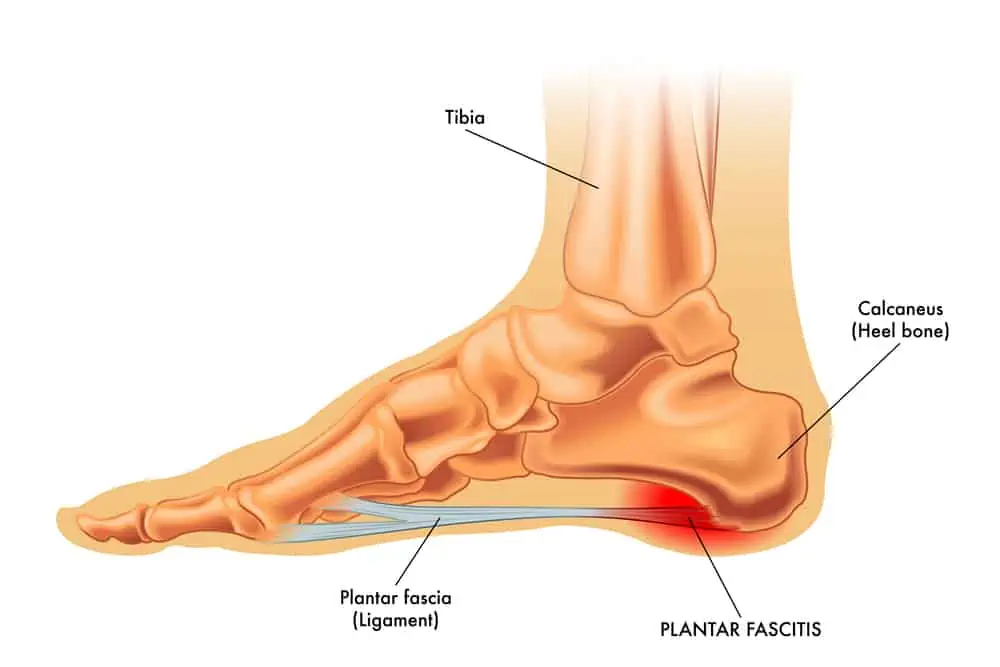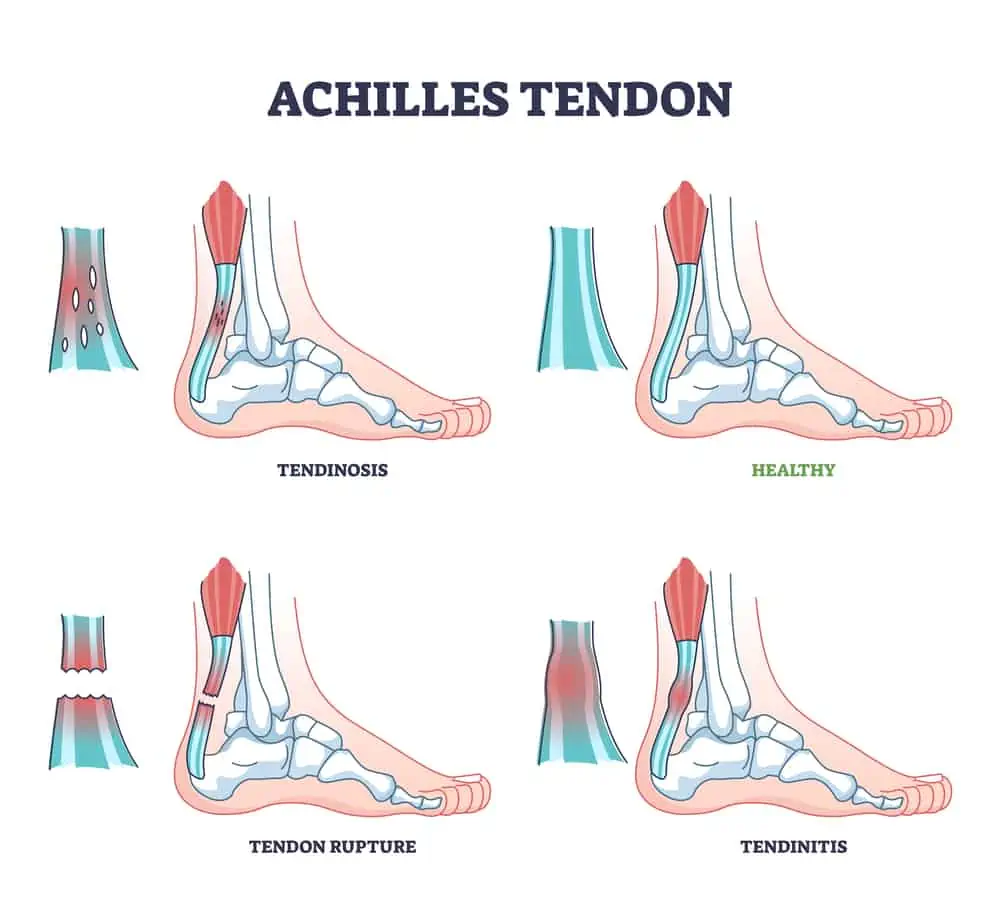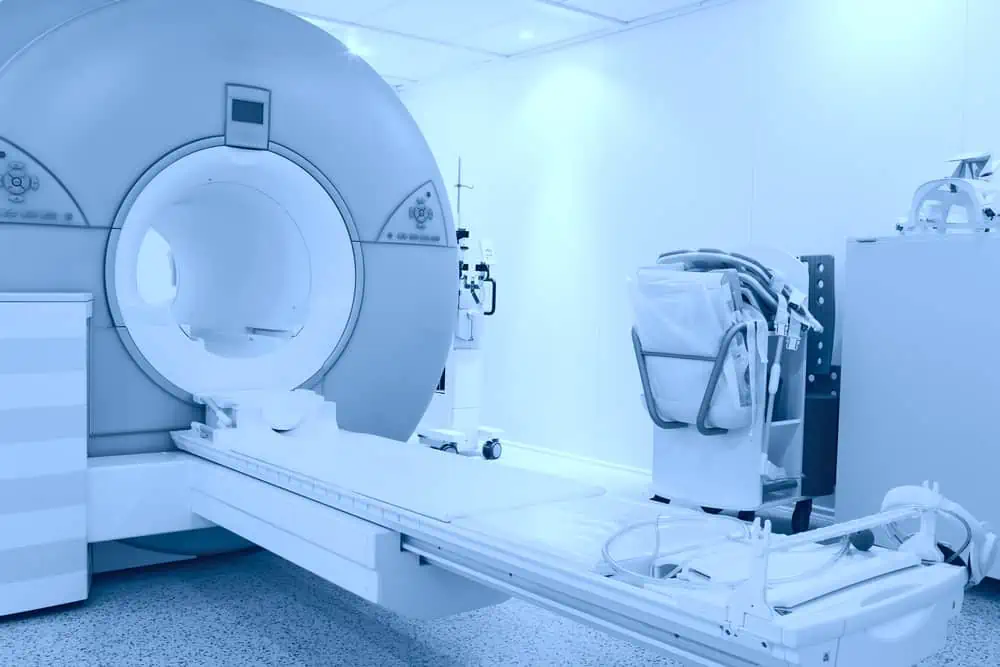This post may contain affiliate links. If you click through a link and make a purchase, I may receive a commission at no additional cost to you. As an Amazon Associate, I earn from qualifying purchases. Read the full disclosure here.
Plantar fasciitis vs. Achilles tendonitis – what’s the difference? After all, these two structures are close neighbors in the human body.
Foot pain, ankle pain, what’s going on?
If you’re a bit confused, don’t worry. This article will quickly and easily break down these two issues’ differences and point you in the right direction for the next steps.
Disclaimer: This content is for educational purposes and is not medical advice. Read the full disclaimer.
What is plantar fasciitis?
The plantar fascia is a thick band of connective tissue that runs along the arch of the foot to the heel bone. It functions to support the arch and transfer force through the foot and lower leg during movement.
When the plantar fascia ligament is asked to pull more than its fair share, it’ll let you know in the form of stabbing pain with every step.
Plantar fasciitis is an inflammation of the fascia at its insertion point on the heel. If the pain becomes chronic, for example, months to years, the condition may be called plantar fasciosis.

There’s also some newer evidence that chronic plantar fasciitis is related to decreased blood flow, which affects the body’s ability to get fresh blood carrying oxygen and other reparative cells to the area to initiate tissue healing.
This finding argues that chronic cases are less about inflammation and more about tissue degeneration, making the condition more multifactorial than originally thought.
Good quality arch supports may help with plantar fascia pain to help provide support to the foot.
To learn more about plantar fasciitis treatment, check out the articles below:
- Surprising Reasons Why Your Plantar Fasciitis Isn’t Getting Better
- Fascia Scraping For Plantar Fasciitis
- Do Toe Spreaders Help Plantar Fasciitis?
Plantar fasciitis symptoms
A hallmark sign of plantar fasciitis is heel pain/arch pain first thing in the morning. The pain may improve as the tissues warm up and may worsen with prolonged walking/standing.
During normal activities, the tissues are warm and move through their full range of motion (ROM).
After sleeping for several hours with your feet in a more relaxed position, those first few steps may cause severe pain as the inflamed tissues progressively warm up and move through their full range of motion.
Plantar fascia pain can also feel worse after prolonged standing and walking activities.
What is Achilles tendonitis?
The Achilles tendon attaches the calf muscles to the heel bone (calcaneus).
Achilles tendonitis (tendinitis, tendinosis, or tendinopathy) is overuse or irritation of the Achilles tendon. Tendonitis refers to more acute inflammation, and tendinopathy or tendinosis is more chronic in nature.

An Achilles tendon rupture is either a partial or full tear of the Achilles.
Unfortunately, Achilles tendonitis treatment is not as simple as resting or adding a few stretching exercises into your routine.
Check out the article below for more information on Achilles tendonitis, including not-so-obvious causes of your pain.
Achilles tendonitis symptoms
Symptoms of Achilles tendinopathy include pain and stiffness (especially in the morning, after sitting for long periods of time, or after exercise) at the point where the tendon inserts into the heel bone (insertional Achilles tendonitis) or further up the tendon.
Other noteworthy signs of Achilles tendon pain may be tenderness to touch or swelling, difficulty performing a heel raise, or pushing off during walking or running.
Achilles tendonitis tends to be more common in men, runners, or those who are ”weekend warriors” (as in being mostly sedentary during the week and saving all of your enthusiasm for the weekends).
There’s also an increased risk for Achilles tendon injury with certain antibiotics or corticosteroid use.
Plantar fasciitis vs. Achilles tendonitis – how to tell them apart
The main difference between plantar fasciitis vs. Achilles tendonitis is the location of the pain and the presentation of symptoms.
Plantar heel pain presents on the bottom of the foot and can be localized at the heel or spread down the foot’s arch. It tends to worsen in the morning and improves with activity, although too much activity may increase pain.
Achilles tendonitis is felt at the back of the ankle, either at the insertion of the tendon or a few inches up the tendon at the back of the ankle. Tendonitis pain typically increases with activity.
It’s possible to have both of these conditions at the same time, especially if you’ve ignored symptoms for a while. Having one injury can change the way that you move and predispose you to develop other overuse injuries.
How do I get better fast?
The million-dollar question. Everyone always wants to know how to get rid of the pain as quickly as possible.
It’s never as easy as “just stretching” or sitting with an ice pack. Most of the first-line home treatment advice out there won’t get you very far.
Both plantar fasciitis and Achilles tendonitis take a multi-pronged approach with some physical activity modification and specific exercises to make a difference. Physical therapy is a good option for both conditions.
An arch support or shoe insert may help bring some much-needed pain relief.
I highly suggest reading the articles below, which are in-depth resources to break down the complexity of these two issues.
- Surprising Reasons Why Your Plantar Fasciitis Isn’t Getting Better
- Why Does My Achilles Feel Tight? (14 Potential Causes)
When to see a doctor
If you’ve been dealing with any of these symptoms or are unsure of what’s going on with your feet, it’s always a good idea to have a formal evaluation instead of self-diagnosing or guessing.
Other injuries and tendinopathies can also occur in the foot and ankle, which require a different treatment approach.
Any “red flag” type symptoms such as redness, swelling, heat (infection concerns), sudden onset numbness or weakness, or any other out-of-the-ordinary symptoms should always be evaluated by a doctor quickly.
Wrapping Up
Plantar fasciitis and Achilles tendonitis are often confused as their locations are not far from each other.
A doctor or physical therapist will be able to distinguish between the two and help you get on treatment options to start feeling better.






